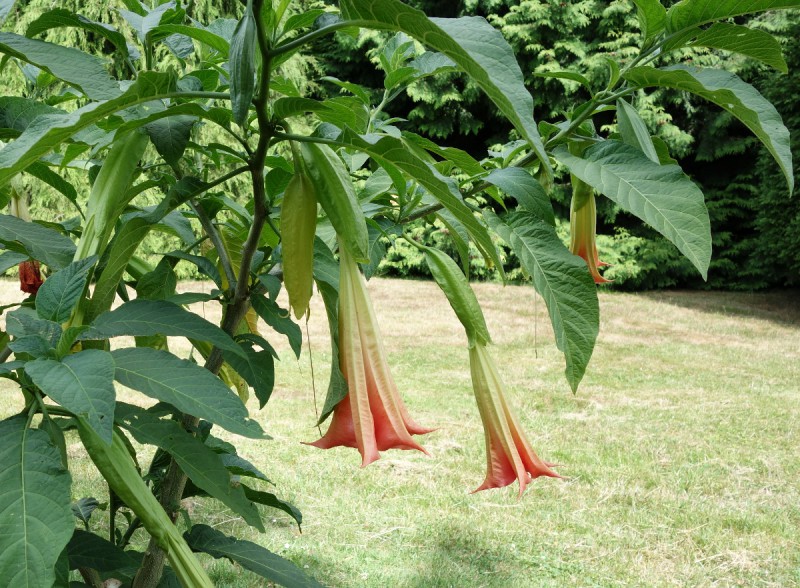Dies ist eine alte Version des Dokuments!
Brugmansia suaveolens (Humb. & Bonpl. ex Willd.) Bercht. & J.Presl - syn.Datura suaveolens Humb. & Bonpl. ex Willd. - Solanaceae
white angel's-trumpet, Duftende Engelstrompete
Shrub or small tree, up to 3–5m high, native to Brazil; leaves are oval, to 25 cm long; flowers sweetly fragrant, about 24–32 cm long. https://en.wikipedia.org/wiki/Brugmansia_suaveolens
The maximum quantity of volatiles is generated by the flowers of B.suaveolens during nighttime, with a peak at around 9 p.m.:
„At that time, the flower smell used to be particularly rich, deep, and very intensive. As it can be appreciated from Table 3, the flower volatile composition varied from hour to hour. Principal component analysis (PCA), applied to the study of B. suaveolens volatiles, permits the differentiation of two groups of flower scent compositions, one typical for the day and another, for nighttime (Fig. 4). The major components of B. suaveolens flower scent were 1,8-cineol, trans-β-ocimene, β-myrcene, sabinene, citronellal, α-terpineol, benzyl alcohol, and methyl salicylate. Flowers generated less volatiles during the morning and up to 3 p.m., but in the afternoon, after sunset and mostly at night, their release
turned to be extremely intensive. Some of the compounds, e.g., indole, benzyl benzoate, benzyl salicylate, and farnesal, were generated at detectable level only during the night, and decreased dramatically with daylight.
Using on-fiber derivatization, and GC-ECD, it was possible to detect selectively some aliphatic aldehydes, such
as C1-C6 (Fig. 5), and nonanal and decanal; were also registered in the chromatograms obtained by HS-SPME with GC-MS analysis.“
[Sampling flower scent for chromatographic analysis, Elena E. Stashenko, Jairo Ren Martnez, J. Sep. Sci. 2008, 31, 2022 – 2031]
„The floral essential oils of Brugmansia suaveolens, from Monteverde, Costa Rica, were collected at three different times of the day by hydrodistillation and the oils analyzed by gas chromatography-mass spectrometry (GC-MS). The floral essential oil showed a dramatic change in composition between the freshly opened night (white) blossoms and the rose-colored senescent blossoms the following day. The white blossoms were dominated by 1,8-cineole (72.1%), (E)-nerolidol (11.7%), α-terpineol (5.3%), and phenethyl alcohol (3.2%), notably different from headspace analyses of B. suaveolens reported previously. The floral essential oil from „rose-colored“ senescent blossoms of B. suaveolens showed dramatic decreases in 1,8-cineole (2.0%), (E)-nerolidol (1.9%), and phenethyl alcohol (not detected), with concomitant increases in heptanal (10.2%), nonanal (17.4%), terpinen-4-ol (10.5%), and megastigmatrienones (35.5%).“
[Composition of the floral essential oil of Brugmansia suaveolens. Anthony, S. J., Zuchowski, W., Setzer, W. N., Records of Natural Products, Vol.3(2), 2009, 76-81] http://www.acgpubs.org/RNP/2009/Volume%203/Issue%201/9_RNP-0812-62.pdf?origin=publication_detail

Brugmansia suaveolens flowering, CC BY-SA 3.0, Author: Andreas Kraska
